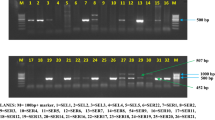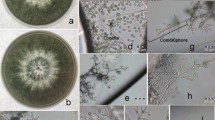Abstract
Trichoderma is known for being the most frequently used biocontrol agent in agriculture. A fundamental part of the Trichoderma antifungal system relies on a series of genes coding for a variety of extracellular lytic enzymes. Characterization of the polymorphism between five putative isoenzymatic activities [β-1,3-glucanase (EC 3.2.1.39, EC 3.2.1.58), β-1,6-glucanase (EC 3.2.1.75), cellulase (EC 3.2.1.4; EC 3.2.1.21, EC 3.2.1.91), chitinase (EC 3.2.1.30, EC 3.2.1.52), protease (EC 3.4.11; EC 3.4.13–19; EC 3.4.21–24, EC 3.4.99)] was carried out using 18 strains from three sections of Trichoderma. Of these, seven strains were from T. sect. Pachybasium, nine from T. sect. Trichoderma and two from T. sect. Longibrachiatum. Thirty-seven different alleles in total were identified: 13 for β-1,3-glucanase, four for β-1,6-glucanase, three for cellulase, eight for chitinase and nine for protease activity. A dendrogram (constructed by the unweighted pair group method with arithmetic averages) based on isoenzymatic data separated the 18 strains into three main enzymatic groups: T. harzianum, T. atroviride/T. viride/T. koningii and T. asperellum/T. hamatum/T. longibrachiatum. Isoenzymatic groupings obtained from biocontrol strains are discussed in relation to their phylogenetic location, based on their sequence of internal transcribed spacer 1 in ribosomal DNA and their antifungal activities.







Similar content being viewed by others
References
Arisan-Atac I, Heidenreich E, Kubicek CP (1995) Randomly amplified polymorphic DNA fingerprinting identifies subgroups of Trichoderma viride and other Trichoderma sp. capable of chestnut blight biocontrol. FEMS Microbiol Lett 126:249–256
Bara MT, Lima AL, Ulhoa CJ (2003) Purification and characterization of an exo-beta-1,3-glucanase produced by Trichoderma asperellum. FEMS Microbiol Lett 219:81–85
Benítez T, Limón C, Delgado-Jarana J, Rey M (1998) Glucanolytic and other enzymes and their genes. In: Kubicek CP, Harman GE (eds) Trichoderma and Gliocladium, vol 2. Taylor and Francis, London, pp 101–127
Bisset J (1991) A revision of the genus Trichoderma. II. Infrageneric classification. Can J Bot 69:2357–2372
Bradford M (1976) A rapid and sensitive method for the quantitation of microgram quantities of protein utilizing the principle of protein–dye binding. Anal Biochem 62:248–254
Campo Rd, Criado JJ, Gheorghe R, González FJ, Hermosa MR, Sanz F, Manzano JL, Monte E, Rodríguez-Fernández E (2004) Thiourea derivatives and their complexes with Ni(II), Co(III) and Pt (II). Crystal structure of 3-benzoyl-1butyl-1-methyl-thiourea and 2-benzyl-6-diethylamino-4-phenyl-2H-[1,3,5] thiadiazine-2-carboxylic acid methyl ester. Antifungal activity. J Inorg Biochem 98:1307–1314
Carsolio CA, Gutiérrez A, Jiménez B, Van Montagu M, Herrera-Estrella A (1994) Characterization of ech-42, a Trichoderma harzianum endochitinase gene expressed during mycoparasitism. Proc Natl Acad Sci USA 91:10903–10907
Chaverri P, Catlebury LA, Samuels GJ, Geiser DM (2003) Multilocus phylogenetic structure within the Trichoderma harzianum/Hypocrea lixii complex. Mol Phylogenet Evol 27:302–313
Chen X, Romaine CP, Tan Q, Schlagnhaufer B, Ospina-Giraldo MD, Royse DJ, Huff DR (1999) PCR-based genotyping of epidemic and pre-epidemic Trichoderma isolates associated with green mould of Agaricus bisporus. Appl Environ Microbiol 65:2674–2678
Chet I, Benhamou N, Haran S (1998) Mycoparasitism and lytic enzymes. In: Harman GE, Kubicek CP (eds) Trichoderma and Gliocladium, vol 2. Taylor and Francis, London, pp 153–173
De la Cruz J, Rey M, Lora JM, Hidalgo-Gallego A, Domínguez F, Pintor-Toro JA, Llobell A, Benítez T (1993) Carbon source control on β-glucanases, chitobiose and chitinase from Trichoderma harzianum. Arch Microbiol 159:316–322
De la Cruz J, Pintor-Toro JA, Benítez T, Llobell A, Romero LC (1995) A novel endo-β-1,3-glucanase, BGN13.1, involved in the mycoparasitism of Trichoderma harzianum. J Bacteriol 177:6937–6945
Delgado-Jarana J, Rincón AM, Benítez T (2002) Aspartyl protease from Trichoderma harzianum CECT 2413: cloning and characterization. Microbiology 148:1305–1315
Donzelli BG, Harman GE (2001) Interaction of ammonium, glucose, and chitin regulates the expression of cell wall-degrading enzymes in Trichoderma atroviride strain P1. Appl Environ Microbiol 67:5643–5647
Enkerly J, Felix G, Boller T (1999) Elicitor activity of fungal xylanase does not depend on enzymatic activity. Plant Physiol 121:391–398
Gams W, Meyer W (1998) What exactly is Trichoderma harzianum Rifai? Mycologia 90:904–915
García-Carreño FL, Dimes LE, Haard NF (1993) Substrate–gel electrophoresis for composition and molecular weight of proteinases or proteinaceous proteinase inhibitors. Anal Biochem 214:65–69
Gower JC (1996) Some distance properties of latent root and vector methods used in multivariate analysis. Biometrika 53:325–328
Grondona I, Hermosa MR, Tejada M, Gomis MD, Mateos PF, Bridge PD, Monte E, García-Acha I (1997) Physiological and biochemical characterization of Trichoderma harzianum, a biological control agent against soilborne fungal plant pathogens. Appl Environ Microbiol 63:3189–3198
Harman GE, Howell CR, Viterbo A, Chet I, Lorito M (2004) Trichoderma species-opportunistic, avirulent plant symbionts. Nat Rev 2:43–56
Hermosa MR, Grondona I, Iturriaga EA, Díaz-Mínguez JM, Castro C, Monte E, García-Acha I (2000) Molecular characterization and identification of biocontrol isolates of Trichoderma spp. Appl Environ Microbiol 66:1890–1898
Hermosa MR, Grondona I, Díaz-Mínguez JM, Iturriaga EA, Monte E (2001) Development of a strain-specific SCAR marker for the detection of Trichoderma atroviride 11, a biological control agent against soilborne fungal plant pathogens. Curr Genet 38:343–350
Hermosa MR, Keck EJ, Chamorro I, Rubio MB, Sanz L, Vizcaíno JA, Grondona I, Monte E (2004) Genetic variability shown by a collection of biocontrol isolates of Trichoderma. Mycol Res 108:897–906
Howell CR (2003) Mechanisms employed by Trichoderma species in the biological control of plant diseases: the history and evolution of current concepts. Plant Dis 87:4–10
Inbar J, Abramski M, Coen D, Chet I (1994) Plant growth enhancement and disease control by Trichoderma harzianum in vegetable seedlings grown under commercial conditions. Eur J Plant Pathol 100:337–346
Keszler A, Forgacs E, Kotali L, Vizcaíno JA, Monte E, García-Acha I (2000) Separation and identification of volatile components in the fermentation broth of Trichoderma atroviride by solid-phase extraction and gas chromatography–mass spectroscopy. J Chromatogr Sci 38:421–424
Kim D, Baek J, Uribe P, Kenerly C, Cook D (2002) Cloning and characterization of multiple glycosyl hydrolase genes from Trichoderma virens. Curr Genet 40:374–384
Kimura M (1980) A simple method for estimating evolutionary rates of base substitutions through comparative studies of nucleotides sequences. J Mol Evol 2:87–90
Kubicek CP, Mach RL, Peterbauer CK, Lorito M (2001) Trichoderma: from genes to biocontrol. J Plant Pathol 83:11–24
Kubicek CP, Bissett J, Druzhinina I, Kullnig-Gradinger C, Szakacs G (2003) Genetic and metabolic diversity of Trichoderma: a case study on south-east Asian isolates. Fungal Genet Biol 38:310–319
Kuhls K, Lieckfeldt E, Samuels GJ, Meyer W, Kubicek CP, Börner T (1997) Revision of Trichoderma section Longibrachitaum including related teleomorphs based on an analysis of ribosomal DNA internal transcribed spacer sequences. Mycologia 89:442–460
Kullnig C, Szakacs G, Kubicek C (2000) Molecular identification of Trichoderma species from Russia, Siberia and Himalaya. Mycol Res 104:1117–1125
Kullnig-Gradinger C, Szakacs G, Kubicek C (2002) Phylogeny and evolution of the genus Trichoderma: a multigene approach. Mycol Res 106:757–767
Laemmli UK (1970) Cleavage of structural proteins during the assembly of the head of bacteriophage T4. Nature 227:680–685
Lee CF, Hseu TH (2002) Genetic relatedness of Trichoderma sect. Pachybasium species based on molecular approaches. Can J Microbiol 48:831–840
Leuchtmann A, Petrini O, Samuels GJ (1996) Isozymes subgroups in Trichoderma section Longibrachiatum. Mycologia 88:384–394
Lieckfeldt E, Samuels GJ, Nirenberg HI, Petrini O (1999) A morphological and molecular perspective of Trichoderma viride: is it one or two species. Appl Environ Microbiol 65:2418–2428
Lorito M (1998) Chitinolytic enzymes and their genes. In: Kubicek CP, Harman GE (eds) Trichoderma and Gliocladium, vol 2. Taylor and Francis, London, pp 73–99
Mach RL, Peterbauer CK, Payer K, Jaksits S, Woo SL, Zeilinger S, Kulling CM, Lorito M, Kubicek CP (1999) Expression of two major chitinase genes of Trichoderma atroviride (T. harzianum P1) is triggered by different regulatory signals. Appl Environ Microbiol 65:1858–1863
Manczinger L, Polner G (1987) Cluster analysis of carbon source utilization patterns of Trichoderma isolates. Syst Appl Microbiol 9:214–217
Mateos PF, Jiménez-Zurdo JI, Chen J, Squartini AS, Haak SK, Martínez-Molina E, Hubbell DH, Dazzo F (1992) Cell-associated pectinolytic and cellulolytic enzymes in Rhizobium leguminosarum biovar trifolii. Appl Environ Microbiol 58:1816–1822
McGrew BR, Green MD (1990) Enhanced removal of detergent and recovery of enzymatic activity following sodium dodecyl sulphate–polyacrylamide gel electrophoresis: use of casein in gel wash buffer. Anal Biochem 189:68–74
Migheli Q, Gonzales-Candelas L, Dealessi L, Camponogara A, Ramón-Vidal D (1998) Transformants of T. longibrachiatum overexpressing the β-1,4-endoglucanase gene egl1 show enhanced biocontrol of Pythium ultimun on cucumber. Phytopathology 88:673–677
Monte E (2001) Understanding Trichoderma: between agricultural biotechnology and microbial ecology. Int Microbiol 4:1–4
Monte E, Bridge PD, Sutton BC (1990) Physiological and biochemical studies in Coelomyces. Stud Mycol 32:21–28
Monte E, Gómez MI, Guerra I, Llobell A, Bautista J (2003) Effect of low molecular chitin on the production of proteins with antifungal activity by Trichoderma atroviride NBT-11. Bull Pol Acad Sci Chem 51:25–34
Montero M, Rey M, González FJ, Sanz L, Monte E, Llobell A (2001) β-1,6-glucanase isozyme system in Trichoderma harzianum. Isolation of two new genes coding for proteins with β-1,6-endoglucanase activity. IOBC/WPRS Bull 24:325–328
Muthumeenakshi S, Mills PR, Brown AE, Seaby DA (1994) Intraspecific molecular variation among Trichoderma harzianum isolates colonizing mushroom compost in British Isles. Microbiology 140:769–777
Ospina-Giraldo MD, Royse DJ, Chen X, Romaine CP (1998) Molecular phylogenetic analyses of biological control strains of Trichoderma harzainum and other biotypes of Trichoderma spp associated with mushroom green mould. Phytopathology 89:308–313
Ospina-Giraldo MD, Royse DJ, Thon MR, Chen X, Romaine CP (1999) Phylogenetic relationship of Trichoderma harzianum causing mushroom green mould in Europe and North America to other species of Trichoderma of world-wide sources. Mycologia 90:76–81
Pan SQ, Ye XS, Kuc J (1989) Direct detection of beta-1,3-glucanase isozymes on polyacrylamide electrophoresis and isoelectrofocusing gels. Anal Biochem 182:136–140
Ramot O, Viterbo A, Friesem D, Oppenheim A, Chet I (2004) Regulation of two homodimer hexosaminidases in the mycoparasitic fungus Trichoderma asperellum by glucosamine. Curr Genet 45:205–213
Samuels GJ, Petrini O, Manguin S (1994) Morphological and macromolecular characterization of Hypocrea schweinitzii and its Trichoderma anamorph. Mycologia 86:421–435
Samuels GJ, Dodd SL, Gams W, Castlebury LA, Petrini O (2002) Trichoderma species associated with the green mould epidemic of commercially grown Agaricus bisporus. Mycologia 94:146–170
Sivasithamparam KY, Ghisalberti EL (1998) Secondary metabolism in Trichoderma and Gliocladium. In: Kubicek CP, Harman GE (eds) Trichoderma and Gliocladium, vol 2. Taylor and Francis, London, pp 139–191
Sneath PHA, Sokal RR (1973) Numerical taxonomy. Freeman, San Francisco
Soler A, De la Cruz J, Llobell A (1999) Detection of β-1,6-glucanase isozymes from Trichoderma strains in sodium dodecyl sulphate–polyacrylamide gel electrophoresis and isoelectrofocusing gels. J Microbiol Methods 35:245–251
Stasz TE, Nixon K, Harman GE, Weeden NF, Kuter GA (1989) Evaluation of phenetic species and phylogenetic relationships in the genus Trichoderma by cladistic analysis of isozymes polymorphism. Mycologia 81:391–403
Suárez B, Rey M, Castillo P, Monte E, Llobell A (2004) Isolation and characterization of PRA1, a trypsin-like protease from the biocontrol agent Trichoderma harzianum CECT 2413 displaying nematicidal activity. Appl Microbiol Biotechnol 65:46–55
Thompson JD, Gibson TJ, Plewniak F, Jeanmougin F, Higgins DG (1997) The Clustal X window interface: flexible strategies for multiple sequence alignment by quality analysis tools. Nucleic Acids Res 24:4876–4886
Tronsmo A, Harman GE (1993) Detection and quantification of N-acetyl-β-d-glucosaminidase, chitobiosidase and endochitinase in solutions and on gels. Anal Biochem 208:74–79
Viterbo A, Ramot O, Chernin L, Chet I (2002a) Significance of lytic enzymes from Trichoderma spp in the biocontrol of fungal plant pathogens. Antonie Van Leeuwenhoek 81:549–556
Viterbo A, Montero M, Ramot O, Friesem D, Monte E, Llobell A, Chet I (2002b) Expression regulation of the endochitinase chit36 from Trichoderma asperellum (T. harzianum T-203). Curr Genet 42:114–122
Zamir D, Chet I (1985) Application of enzyme electrophoresis for the identification of isolates in Trichoderma harzianum. Can J Bot 31:578–580
Zimand G, Valinsky L, Elad Y, Chet I, Manulis S (1994) Use of the RAPD procedure for the identification of Trichoderma strains. Mycol Res 98:531–534
Acknowledgements
We want to thank Emma J. Keck for the critical revision of this manuscript. The present study was funded with grants from the European Commission (FAIR6-CT98-4140) and the Fundación Andaluza de I+D (Sevilla, Spain).
Author information
Authors and Affiliations
Corresponding author
Additional information
Communicated by U. Kück
Rights and permissions
About this article
Cite this article
Sanz, L., Montero, M., Grondona, I. et al. Cell wall-degrading isoenzyme profiles of Trichoderma biocontrol strains show correlation with rDNA taxonomic species. Curr Genet 46, 277–286 (2004). https://doi.org/10.1007/s00294-004-0532-6
Received:
Revised:
Accepted:
Published:
Issue Date:
DOI: https://doi.org/10.1007/s00294-004-0532-6




